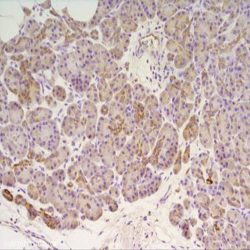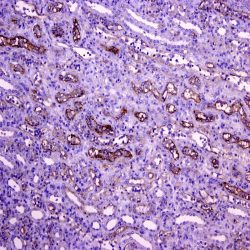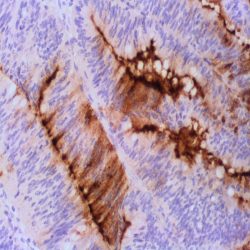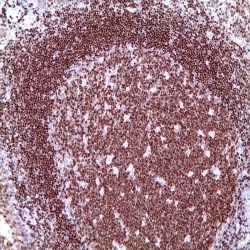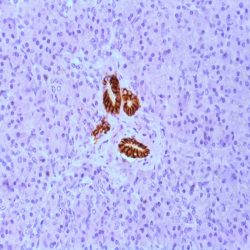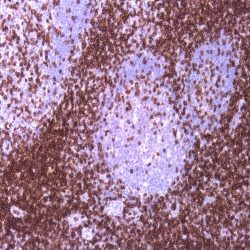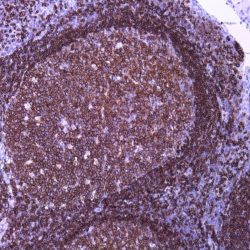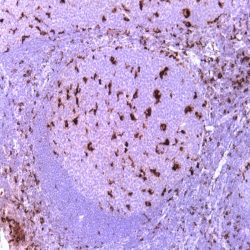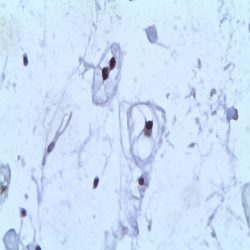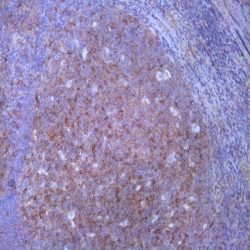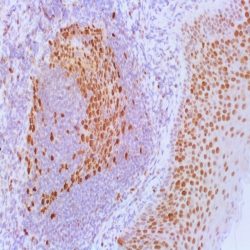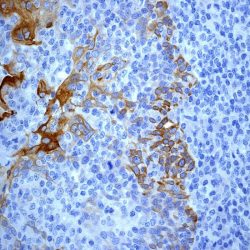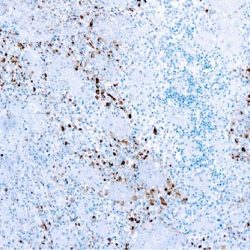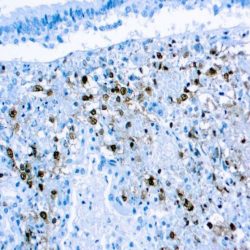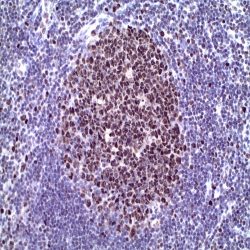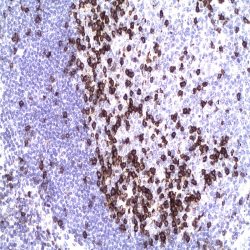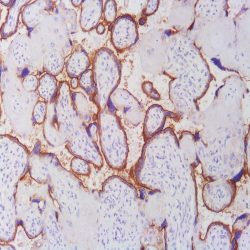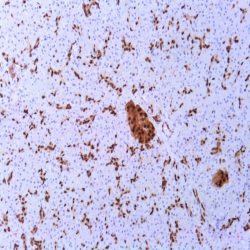Category: IHC-Antibodies
Showing 241–260 of 923 results
فیلتر ها-
آنتی بادیهای ایمونوهیستوشیمی
آنتی بادی Alpha-1-Antichymotrypsin (Polyclonal)
Rated 0 out of 5Name: Alpha-1-Antichymotrypsin (Polyclonal)
Description and applications: This antibody reacts with the human alpha-1- antichymotrypsin, a surfactant protein in acute phase of the inflamation, plus a serpin that inactivates preferably the chymotrypsin, the cathepsin G and the chymase. As an inhibitor protein of serine protease, it is closely related to the neuritic plaques in the Alzheimer’s disease and in human and monkey brains with normal aging signs. The regulation of serine proteases and their inhibitors have an important function in the neuromuscular pathology differential diagnosis. The alpha-1-antichymotrypsin binds primarily to the prostate specific antigen (PSA), a serine protease similar to the chymotrypsin, to form a complex. Furthermore, this antibody can be used to identify hematopoietic cells of the monocyte-macrophage series and neoplasias derived from them.
Composition: anti-human Alpha-1-Antichymotrypsin rabbit polyclonal antibody purified from serum and prepared in 10mM PBS, pH 7.4, with 0.2% BSA and 0.09% sodium azide
Clone: Polyclonal
Ig isotype: Rabbit IgG
IHC positive control: Macrophages in the tonsils.
Visualization: Cytoplasmic.
-
آنتی بادیهای ایمونوهیستوشیمی
آنتی بادی C3d Complement Component (Polyclonal)
Rated 0 out of 5Name: C3d Antibody
Description and applications: This antibody recognises the C3d fragment of the complement. Component C3 can be activated through both classical and alternative complement pathways. Among the different complement proteins, C3 and C4 opsonins have a protective thioester radical. This molecule enables C3 (and C4) complement fragments to form covalent bonds when activated by the target molecule, generating C3b. The proteolytic cleavage of C3b generates the C3d fragment, which remains covalently attached to the target structure, while the C3c fragment is released. The C3d fragment is stable and it can be identified in paraffin-embedded biopsies. Under normal conditions, renal glomerular capillaries are stained. In transplants, the identification of diffuse deposits of C3d and C4d in renal peritubular capillaries or cardiac capillaries supports the diagnosis of acute humoral rejection of the graft. Deposits of C3d have been identified in grafts with chronic rejection but its significance has yet to be clarified. Deposition of C3d on paraffin-embedded biopsies from skin inflammatory pathologies has been demonstrated by different authors. Magro and Dyrsen identified prominent granular C3d deposits along the dermoepidermal junction for all discoid lupus erythematosus (20/20) and systemic LE (5/5) cases. In systemic LE, vascular C3d or C4d deposits were shown. All cases of urticarial (5), leukocytoclastic (6), and lymphocytic (1) vasculitis exhibited prominent mural C3d and C4d deposits in vessels, whereas Henoch-Schönlein purpura (10/10) showed only C3d deposits. Pfaltz et al found deposits of C3d at the epidermal basement membrane in 97% (31/32) of bullous pemphigoid cases.
Composition: anti-human C3d Complement Component rabbit polyclonal antibody purified from serum and prepared in 10mM PBS, pH 7.4, with 0.2% BSA and 0.09% sodium azide
IHC positive control: Kidney tissue section with acute humoral rejection.
-
آنتی بادیهای ایمونوهیستوشیمی
آنتی بادی CA 19-9 (121SLE)
Rated 0 out of 5Name : Antibody Ca19-9 clone 121SLE
Description and applications: CA19-9 antigen is highly expressed in gastrointestinal (gastric, pancreatic, and colonic) adenocarcinomas and salivary gland mucoepidermoid carcinomas. Anti- CA19-9 antibody is usually not reactive with breast, kidney, and prostate carcinomas. Anti-human CA19-9 mouse monoclonal antibody purified from serum and prepared in 10mM PBS, pH 7.4, with 0.2% BSA and 0.09% sodium azide
Composition:Anti-human CA19-9 mouse monoclonal antibody purified from serum and prepared in 10mM PBS, pH 7.4, with 0.2% BSA and 0.09% sodium azide.
-
آنتی بادیهای ایمونوهیستوشیمی
آنتی بادی PAX-8 (MD-50 also known as MRQ-50)
Rated 0 out of 5Name: Pax-8 Antibody clone MD-50 also known as MRQ-50
Description and applications:PAX8 antibody recognizes a protein of 62kDa, identified as PAX8. It is a member of the paired box (PAX) family of transcription factors. This nuclear protein is involved in thyroid follicular cell development and expression of thyroid-specific genes. Mutations in this gene have been associated with thyroid dysgenesis, thyroid follicular carcinomas, and atypical thyroid adenomas. PAX8 is expressed in the normal thyroid follicular cells and associated carcinomas. As a marker of mesonephric and müllerian organs, ovarian and renal normal and neoplasms are frequently positive. For that, non-ciliated mucosal cells of the fallopian tubes, and simple ovarian inclusion cysts and normal ovarian surface epithelial cells are positive. PAX8 is expressed in a high percentage of ovarian serous, endometrioid, and clear cell carcinomas, but only rarely in primary ovarian mucinous adenocarcinomas. PAX8 antibody may be used as an additional immunohistochemical marker for renal epithelial tumors as it is expressed by all the segments of the nephron and the great majority of renal tumours including sarcomatoid carcinomas. Thymic and parathyroid carcinomas and isolated cases of urothelial carcinomas, sex-cord stromal tumours of the ovary or squamous carcinomas of the lung have showed weak and focal positivity.
Composition:Anti-human PAX-8 mouse monoclonal antibody purified from serum and prepared in 10mM PBS, pH 7.4, with 0.2% BSA and 0.09% sodium azide
-
آنتی بادیهای ایمونوهیستوشیمی
آنتی بادی Cadherin 17 (SP183)
Rated 0 out of 5Name:Cadherin 17 Antibody clone SP183
Description and applications: Cadherins represents a big family of Ca2+ dependent transmembrane cell adhesion glycoproteins that interact homophilically with each other and thus participate in the heterologous cell selection. They play a key role in the embryonic development and in the maintenance of the normal structure in adult tissues. Molecular defects in the structure of cadherins represent important pathogenic aspects of many diseases, including cancer. The cadherin 17 gene (CDH17) is located on the chromosome region 8q22.1 that encodes a protein of 832 amino acids and approximately 92kDa of molecular weight. Cadherin 17, also known as human peptide transporter 1 (HPT-1) or liver-intestine cadherin (LICadherin), is located in the lateral contact areas of the intestinal epithelial cells, being undetectable in the stomach, kidney, lung or liver, among other organs. It
features many structural similarities with the kidney specific cadherin, both belonging to the 7D-cadherin family. In tumors, the great specificity of cadherin 17 to identify the primary or metastatic colorectal adenocarcinomas has been demonstrated. Less frequently, cadNherin 17 has been described in gastroesophageal junction adenocarcinomas or adenocarcinomas with gastric origin. In the few available studies, cadherin 17 has shown staining in all well-differentiated neuroendocrine tumors (carcinoid tumors) originated in the small intestine and in the appendix. Up to 80% of the primary pancreatic adenocarcinomas and only half of their metastases are usually positive. Up to 50% of cholangiocarcinomas show membrane staining against cadherin 17, showing greater sensitivity than other markers such as villin, CDX2 or SATB2, which can be used to refine the diagnosis. Cadherin 17 shows along with SATB2 greater sensitivity in the detection of medullar carcinomas of the large intestine that are usually negative for CDX2 and cytokeratins 7 and 20.Composition: Anti-human Cadherin 17 rabbit monoclonal antibody purified from serum and prepared in 10mM PBS, pH 7.4, with 0.2% BSA and 0.09% sodium azide
-
آنتی بادیهای ایمونوهیستوشیمی
آنتی بادی CD3 (EP41)
Rated 0 out of 5Name: CD3 Antibody clone EP41
Description and applications: CD3 (Cluster of Differentiation 3) is a complex of proteins that associates directly with the T cell antigen receptor (TCR). CD3 is composed of five invariant polypeptide chains that associate to form three dimers. The five invariant chains of CD3 are labeled gamma, delta, epsilon, zeta, and eta. The CD3 is involved in T cell development and survival. It is expressed on T cells in thymus, peripheral lymphoid tissue, blood and bone marrow. CD3 is a commonly used marker for identification of T cell and T cell derived malignancies. This CD3 antibody has been validated by the 9th International Conference on Human Leukocyte Differentiation Antigens (HLDA9).
Composition: Anti-human CD3 rabbit monoclonal antibody purified from serum and prepared in 10mM PBS, pH 7.4, with 0.2% BSA and 0.09% sodium azide
Intended use: Immunohistochemistry (IHC) on paraffin embedded tissues. Not tested on frozen tissues or Western-Blotting
Species reactivity: In vitro diagnostics in humans. Not tested in other species
-
آنتی بادیهای ایمونوهیستوشیمی
آنتی بادی CD45RA (SPM504)
Rated 0 out of 5Name: CD45RA Monoclonal Antibody clone SPM504
Description and applications: This antibody reacts with the CD45RA isoform with a molecular mass of 220 kD. CD45RA is present in peripheral blood B cells, follicular mantle and centre, medullary thymocytes, monocytes, and mature T cells that have not been modulated by antigenic contact. In this regard, and after immune processing in the thymus, T cells are released into peripheral blood to colonize secondary lymphoid organs, including spleen, lymph nodes, and mucosa-associated lymphoid tissue (MALT). These lymphocytes, not yet activated in vivo by antigens (naive cells), are phenotypically characterized by the co-expression of the highest molecular mass CD45 isoforms, CD45RAC and CD45RA, and CD62L (peripheral lymph node homing receptor), a decisive molecule for the fixation of cells in thymus-dependent areas of secondary lymphoid organs. When these cells are stimulated by its specific antigen expressed by the corresponding antigen-presenting cells and are transformed into effector T cells, either CD4- or CD8-positive or memory T cells, CD45RA and CD62L expression disappears, the former being replaced by the lower molecular mass CD45R0 isoform, and the latter, by various type 1 and type 2 integrins and APO-1/Fas receptor (CD95), an apoptosis inducer. The CD45 molecule, also called leukocyte common antigen, is a membrane glycoprotein that occupies up to 10% of the surface of cells expressing it. In mammals, its homology varies markedly between the intracytoplasmic region (greater than 90%) and the extracellular region (only 35%, although with similar domain organization). Structurally, there are multiple CD45 isoforms determined by the different possible ways of joining exons 4, 5, and 6 during the synthesis of the mRNA encoding the extracellular domain of the protein. These isoforms are referred to as A, B, and C, using the RABC terminology for the bigger isoform, which includes all three exons, RA and RB when the exonic expression is restricted to one of these exons, and RO to designate the smaller molecule, which lacks all three exons. The sequence of these three exons includes multiple oxygen-linked glycosylation sites that can be variably modified by sialic acid. This, on the one hand, causes the molecular mass of the different isoforms to vary between 180 kD (RO) and 240 kD (RABC); on the other hand, it gives these molecules remarkable differences in terms of their shape and anionic charge. The rest of CD45’s extracellular domain shows marked nitrogen-linked glycosylation and contains a cysteine-rich region followed by three amino acid repeats analogous to fibronectin type III domain. CD45’s high degree of glycosylation, attributable to both sialic acid and oligosaccharides on the variable domains and N-glycoconjugates on the constant extracellular domain, plays an important role in the functional activity of the molecule, as demonstrated by the interaction between CD45RO of T cells and B cells expressing CD22 or the mannose hybrids on CD45 in the development of immature thymocytes. The rest of the CD45 molecule consists of a single transmembrane domain followed by a long intracytoplasmic tail containing two tandem-placed identical domains (D1 and D2) with protein-tyrosine phosphatase (PTPase) homology. Of these domains, only D1 possesses enzymatic activity capable of rescuing TCR signal activation in CD45-deficient cell lines. The function of D2 is hardly understood, although it seems to contribute to the molecule’s intracytoplasmic stability. Although in in vitro models the extracellular domain of CD45 is not essential for its intracytoplasmic function, the exonic transcription of this domain is strongly regulated depending on the cell type that expresses it, its development, and its degree of activation, thus playing an important functional role in vivo.The CD45RA epitope recognized by the MB1 antibody is useful for the study of B-cell lymphomas; however, as some of them are not positive against it, it is advisable to use it as part of a large panel of antibodies. Because the epitope recognized by MB1 may be altered by prolonged formol fixation, and in order to ensure a correct interpretation of results, it is appropriate to check that at least some normal B cells in the histological section are stained. The antibody shows no reactivity against cortical thymocytes, immature T cells, and activated B cells. This antibody reacts against human tissue. In other species, it has not been tested.
Composition: Anti-human CD45RA mouse monoclonal antibody purified from serum and prepared in 10mM PBS, pH 7.4, with 0.2% BSA and 0.09% sodium azide
-
آنتی بادیهای ایمونوهیستوشیمی
آنتی بادی CD68 (KP-1)
Rated 0 out of 5Name: CD68 Monoclonal Antibody clone KP-1
Description and aplications: Anti-CD68 marks cells of monocyte/macrophage lineage. This antibody is capable of staining monocytes, Kupffer cells, osteoclasts, NK cells, granulocytes and their precursors; lymphomas are negative or show a few granules. This antibody may be useful for the identification of myelomonocytic and histiocytic tumors. Anti-CD68 may help to distinguish malignant fibrous histiocytoma from other pleomorphic sarcomas. However, since this detects a formalinresistant epitope that may be associated with lysosomal granules, other lysosome-rich cells may also stain.
Composition: Anti-human CD68 mouse monoclonal antibody purified from serum and prepared in 10mM PBS, pH 7.4, with 0.2% BSA and 0.09% sodium azide
-
آنتی بادیهای ایمونوهیستوشیمی
آنتی بادی Cdk4 (DCS-35)
Rated 0 out of 5Name: Anti-human CDK4 Mouse Monoclonal Antibody clone DCS-35
Description and aplications: Cell cycle progression is controlled in part by a family of cyclin proteins and cyclin dependent kinases (Cdks). Cdk proteins work in concert with the cyclins to phosphorylate key substrates involved in each phase of cell cycle progression.
Another family of proteins, Cdk inhibitors, also plays a role in regulating the cell cycle by binding to cyclin-Cdk complexes and modulating their activity. Several Cdk proteins have been identified, including Cdk2-Cdk8, PCTAIRE-1-PCTAIRE-3, PITALRE and PITSLRE. Cdk4, in complex with D-type cyclins, is thought to regulate cell growth during the G1 phase of the cell cycle. This association with a D-type cyclin upregulates Cdk4 activity, whereas binding to the Cdk inhibitor p16 downregulates Cdk4 activity. Activation of the Cdk4-cyclin complexes requires phosphorylation on a single threonyl residue of Cdk4, catalyzed by a Cdk-activating protein (CAK).Composition: Anti-human CDK4 mouse monoclonal antibody purified from serum and prepared in 10mM PBS, pH 7.4, with 0.2% BSA and 0.09% sodium azide
Intended use: Immunohistochemistry (IHC) on paraffin embedded tissues. Not tested on frozen tissues or Western-Blotting
-
آنتی بادیهای ایمونوهیستوشیمی
آنتی بادی CD95 (EP208)
Rated 0 out of 5Name: CD95 Monoclonal Antibody clone EP208
Description and aplications: The CD95 (Fas) protein is a cell surface receptor belonging to the tumor necrosis factor (TNF) family that transduces death signaling on engagement by multimeric Fas ligand (CD95L), of which there are eight in its membrane–bound form or in its soluble form resulting from cleavage by a putative metalloproteinase. CD95 is a widely expressed protein. CD95-mediated apoptosis is an essential mechanism for the maintenance of normal tissue homeostasis, and disruption of this death pathway has been associated with a wide range of human diseases, including autoimmune diseases, lymphoproliferative disorders and malignancies. The Fas death system also plays important roles in various apoptosis conditions such as those evoked by irradiation, chemotherapeutic
agents and viral infections. The expression of CD95 serves as a prognostic marker in predicting the outcome of disease progression and treatment in many types of tumors.Composition: Anti-human CD95 rabbit monoclonal antibody purified from serum and prepared in 10mM PBS, pH 7.4, with 0.2% BSA and 0.09% sodium azide
-
آنتی بادیهای ایمونوهیستوشیمی
آنتی بادی CNPasa (11-5B)
Rated 0 out of 5Name: CNPase Monoclonal Antibody clone 11-5B
Description and aplications: This monoclonal antibody recognises two proteins with a molecular mass of 46 kD (CNP1) and 48 kD (CNP2), identified as CNPase isoforms. CNPase (2’,3’-cyclic nucleotide 3′-phosphodiesterase) is expressed at high levels in oligodendrocytes of the central nervous system and in Schwann cells of the peripheral nervous system and it is virtually absent in other cell types. Since CNPase is expressed early in postnatal development, this antibody is useful for the identification of oligodendrocytes and Schwann cells. CNPase activity is decreased in demyelinating diseases such as multiple sclerosis. The CNPase gene is located on chromosome 17q21, very close to the familial breast cancer gene BRCA1. This antibody shows cross-reactivity with monkey, cow, sheep, goat, pig, cat, dog, rabbit, rat, and mouse. It does not cross-react with guinea pig and chicken.
Composition: Anti-human CNPase mouse monoclonal antibody purified from serum and prepared in 10mM PBS, pH 7.4, with 0.2% BSA and 0.09% sodium azide
Intended use: Immunohistochemistry (IHC) on paraffin embedded tissues. Not tested on frozen tissues or Western-Blotting
-
آنتی بادیهای ایمونوهیستوشیمی
آنتی بادی Cytokeratin 17 (EP98)
Rated 0 out of 5Name: Cytokeratin 17 Monoclonal Antibody clone EP98
Description and aplications: The widely known intermediate filaments proteins, which measure between 7 and 22 nm diameter (that is, a size between the one of the actin -5-7 nm and the tubulin -22-25 nm-), along with the previous ones, belong to the cytoskeleton of the vertebrates. This superfamily is made up of six subfamilies of molecules with different tissue expressions. Cytokeratins make up the homology I and II in humans. They are encoded in more than 49 different genes in the chromosomes 17 (I) and 12 (II). The nomenclature adopted in 1982 by Moll and Franke assigns the ranks 1 to 8 for the type II cytokeratins (neutral or basic) and between 9 and 21 for the type I (acid). Nowadays, an analogue nomenclature has been defined to name the hair keratin with theaddition of the Ha and Hb letters to separate the ones of the group I from group II. Structurally speaking, cytokeratins share with the rest of intermediate filaments a central axis of 310 amino acids made up of four α-helices domains (1A, 1B, 2A and 2B) highly preserved that define the type of intermediate filament that they will make up after its packing, separated by three non-helix binding sites (L1, L12 and L2) and two extreme domains highly different in size and sequence (head-1- and tail-2-), each of them with constant (E1/E2), variable (V1/V2) and homology regions (H1/H2), the last ones are characteristic of the type II keratins and absent of the type I. In variable domains, they have the most immunogenic properties and he main differences between each type of keratin. Usually, keratins assemble in heterodimers I/II and they co-express in pairs specifically in each tissue. Cytokeratin 17 of 46 KDa of molecular mass is a type I intermediate filament with an isoelectric point of 5.1 encoded by the gene of the same name located in the chromosome 17. Cytokeratin 17 is expressed in the basal and suprabasal cells of complex epithelium of the skin and skin adnexa. Furthermore, it is expressed in the basal cells of the pseudostratified epithelium of the trachea, larynx and bronchus. This antibody reacts with myoepithelial cells of the salivary and sweat glands. This antibody is useful to diagnose epithelial neoplasias that express cytokeratin 17 such as basal cell carcinomas, squamous lung cancers, adenoid cystic and mucoepidermoid salivary gland carcinomas, mesotheliomas, cholangiocarcinomas and numerous lung adenocarcinomas (>50%), colorectal adenocarcinomas (<50%), pancreatic adenocarcinomas (30%). Cytokeratin 17 is not detected in gastric adenocarcinomas, mucinous colorectal adenocarcinomas, hepatocellular carcinomas and Merkel-cell carcinomas.
Composition: Anti-human Cytokeratin 17 rabbit monoclonal antibody purified from serum and prepared in 10mM PBS, pH 7.4, with 0.2% BSA and 0.09% sodium azide
-
آنتی بادیهای ایمونوهیستوشیمی
آنتیبادی Herpes Simplex Virus I (Polyclonal)
Rated 0 out of 5Name: Herpes Simplex Virus I Antibody
Description and aplications: Herpes simplex virus is quite ubiquitous and is quite variable in it’s presentation in human disease. Type I usually infects the non-genital mucosal surfaces. It may affect the skin or internal organs (typically brain, lung, liver, adrenal gland, or GI tract) of immunocompromised individuals. This polyclonal antibody reacts with Type I Herpes viruses. There may be cross-reactivity with varicella zoster virus at higher concentrations. Crossreactivity with CMV or Epstein-Barr virus is not seen with this antibody.
Composition: anti-human Herpes Simplex Virus Irabbit polyclonal antibody purified from serum andprepared in 10mM PBS, pH 7.4, with 0.2% BSA and0.09% sodium azide
Intended use: Immunohistochemistry (IHC) on paraffin embedded tissues. Not tested on frozen tissues or Western-Blotting
-
آنتی بادیهای ایمونوهیستوشیمی
آنتی بادی Herpes Simplex Virus II (Polyclonal)
Rated 0 out of 5Name: Herpes Simplex Virus II Antibody
Description and aplications: Herpes viruses type 1 and 2 (HSV-1 and HSV-2) belong to the family of herpesviridae. Its genome consists of a linear double molecule of DNA of approximately 100,000 kD encoding more than 75 gene products. The homology between the genomic structure of HSV-1 and 2 is of approximately 50%, so that while most of the polypeptides encoded for each type of herpes virus have a similar structure and are antigenically related, there are numerous proteins of both viruses that condition particular responses of the host’s immune system and allow its serological and immunohistochemical differentiation. The monoclonal antibody described herein reacts with the herpes simplex virus type 2 and is useful in detecting HSV II induced lesions. At high concentrations, cross-reactivity has been observed against some strains of the varicella zoster virus. The antibody does not react against CMV or Epstein-Barr virus cultures.
Composition: anti-human Herpes Simplex Virus II rabbit polyclonal antibody purified from serum and prepared in 10mM PBS, pH 7.4, with 0.2% BSA and 0.09% sodium azide
-
آنتی بادیهای ایمونوهیستوشیمی
آنتی بادی ISLET 1 (EP283)
Rated 0 out of 5Name: Islet 1 Monoclonal Antibody clone EP283
Description and aplications: Islet-1, Insulin gene enhancer protein ISL-1, is a protein that in humans is encoded by the ISL1 gene. This gene encodes a transcription factor containing two N-terminal LIM domains and one C-terminal homeo domain. The encoded protein plays an important role in the embryogenesis of pancreatic islets of Langerhans. ISL1 has been shown to interact with Estrogen Receptor alpha. Islet-1 produces a strong nuclear staining in the islets of normal pancreas and tumor cells of the pancreatic neuroendocrine tumors. Islet-1 has been found to be a reliable marker of pancreatic endocrine tumors and metastasis. It shows a comparable sensitivity and specificity as CDX2 as a marker of ileal and appendiceal neuroendocrine tumors and their metastasis. A panel of Islet-1, CDX2 and TTF1 may be useful in differentiation well-differentiated endocrine carcinomas of unknown origin.
Composition: Anti-human Islet 1 rabbit monoclonal antibody purified from culture supernatant, filtered, sterilized and prepared in 10mM PBS, pH 7.4, with 0.2% BSA and 0.09% sodium azide
-
آنتی بادیهای ایمونوهیستوشیمی
آنتی بادی Mucin 1 (ZM35 also known as MRQ-17)
Rated 0 out of 5Name: Mouse anti-human Mucin 1 Monoclonal Antibody clone ZM35
Description and aplications: Mucins are high molecular weight glycoproteins which constitute the major component of the mucus layer that protects the gastric epithelium from chemical and mechanical aggressions. In humans, at least 14 mucin genes have been identified that code for the mucin proteins. They are designated as MUC1, MUC2, MUC3, MUC4, MUC5AC, MUC5B, MUC6, MUC7, MUC8, MUC9, MUC11, MUC12, MUC13, and MUC16. The heterogeneous pattern of mucin expression, including the expression of the intestinal mucin MUC2, may provide new insights into the differentiation pathways of gastric carcinoma. Comparative studies showed that: (1) mucin expression is associated with tumor type (MUC5AC with dffuse and infiltrative carcinomas and MUC2 with mucinous carcinomas) but not with the clinicobiological behavior of the tumors; and (2) mucin expression is associated with tumor location (MUC5AC with antrum carcinomas and MUC2 with cardia carcinomas).
Composition: Anti-human Mucin 1 mouse monoclonal antibody purified from serum and prepared in 10mM PBS, pH 7.4, with 0.2% BSA and 0.09% sodium azide
Intended use: Immunohistochemistry (IHC) on paraffin embedded tissues. Not tested on frozen tissues or Western-Blotting
-
آنتی بادیهای ایمونوهیستوشیمی
آنتی بادی PCNA (PC10)
Rated 0 out of 5Name: PCNA (Proliferating Cell Nuclear Antigen) Monoclonal Antibody clone PC10
Description and aplications: Expression of proliferating cell nuclear antigen (PCNA) or cyclin or polymerase delta auxiliary protein is elevated in the nucleus during late G1 phase immediately before the onset of DNA synthesis, becoming maximal during S-phase and declining during G2 and M phases. Its level correlates directly with rates of cellular proliferation and DNA synthesis. PCNA/cyclin may act as an auxiliary protein of DNA polymerase-delta to play a fundamental role in the initiation of cell proliferation The level of PCNA expression is directly related to the rate of cell proliferation and DNA synthesis. PCNA / cyclin could act as an auxiliary protein of DNA polymerase delta, which plays an essential role in the initiation of cell proliferation.This antibody is useful tool for studying the proliferating cells in normal tissues and its potential aberrant expression in neoplasms
Composition: anti-human PCNA mouse monoclonal antibody purified from ascites fluid by Protein A chromatography. Prepared in 10mM PBS, pH 7.4, with 0.2% BSA and 0.09% sodium azide
Immunogen: Recombinant rat PCNA protein
-
آنتی بادیهای ایمونوهیستوشیمی
آنتی بادی PD-1 (NAT105)
Rated 0 out of 5Name:PD-1 Antibody clone NAT105
Description and aplications: Programmed death-1 (PD-1) is a member of the CD28 family of receptors that includes CD28, cytotoxic T-lymphocyteassociated antigen 4 (CTLA-4), inducible costimulator (ICOS), and B- and T-lymphocyte attenuator. These receptors play a role in the cellular immune response. For example, CD28 serves as a costimulatory receptor that enhances T-cell activation, whereas CTLA-4 serves as an inhibitor of T-cell activation. PD-1 also has an inhibitory function on T cells and B cells, and is important in peripheral tolerance. There are at least 2 ligands for PD-1, PD-L1, and PD-L2, which are expressed on a range of cells.
CD28 is constitutively expressed on most or all CD4+ T cells and approximately 50% of CD8+ T cells, whereas CTLA-4 is not expressed on resting T cells. PD-1 is also expressed on activated T cells, B cells, and myeloid cells. Iwai and coworkers studied the microanatomic distribution of PD-1 in human tonsil and found that PD-1 is expressed on most T cells and a small subset of B cells in the light zone of germinal centers, but not elsewhere in the tonsil. On that basis, it was postulated that PD-1 may play a role in the process of clonal selection of centrocytes, which occurs in this subanatomic site in germinal centers.Composition: anti-human PD-1 mouse monoclonal antibody purified from ascites. Prepared in 10mM PBS, pH 7.4, with 0.2% BSA and 0.09% sodium azide
-
آنتی بادیهای ایمونوهیستوشیمی
آنتی بادی PD-L1 (CAL10)
Rated 0 out of 5Name: PD-L1 Monoclonal Antibody clone CAL10
Description and applications:Programmed death ligand 1 (PD-L1, also known as CD274) inhibits tumor-reactive T cells via binding to the programmed death-1 (PD-1) receptor, rendering tumor cells resistant to CD8+ T cell-mediated lysis. Studies have shown that the inhibitory receptor PD-1 is expressed on tumor-infiltrating lymphocytes (TIL) while PD-L1 is expressed on tumor cells. Assessment of PD-L1 expression in combination with CD8+ TIL density may be a useful predictive metric in multiple cancers, including stage III NSCLC, hormone receptor negative breast cancer and sentinel lymph node melanoma. Clinical trials utilizing humanized chimeric antibodies that block inhibitory checkpoints, such as anti-PD-1 and anti-PD-L1, have demonstrated delayed tumor growth and increased survival. While identification of PD-L1 overexpression by IHC is not yet standardized, it has become increasingly important to identify these tumors, as a directed therapy may improve clinical outcomes in these patients. In cutaneous melanoma, the targeting of PD1/PD-L1 has provided meaningful clinical benefit for patients in just the past 5-10 years. The use of IHC for protein identification, along with novel therapies, such as checkpoint inhibitors and vaccines, are generating new options for the treatment of cancer patients. The PD-L1 [CAL10] clone does not cross react with PDL2.
Composition: Anti-human PD-L1 rabbit monoclonal antibody purified from serum and prepared in 10mM PBS, pH 7.4, with 0.2% BSA and 0.09% sodium azide
Intended use: Immunohistochemistry (IHC) on paraffin embedded tissues. Not tested on frozen tissues or Western-Blotting
Immunogen: Peptide corresponding to the region within human PD-L1.
-
آنتی بادیهای ایمونوهیستوشیمی
آنتی بادی PDX1 (EP139)
Rated 0 out of 5Name: PDX1 Monoclonal Antibody clone EP139
Description and applications: The homeobox 1 duodenal protein (PDX1) is a transcription factor that is required for the embryonic development of the pancreas and the maturation of the β-cells of the islets of Langerhans. Moreover, PDX1 activates somatostatin, glucokinase, islet amyloid polypeptide, and glucose transporter type 2 gene transcription. The PDX1 protein is encoded by the PDX1 gene, located in the chromosomal region 13q12.2. Clinically, mutations in the PDX1 gene have been shown to cause pancreatic agenesis and hereditary maturity onset diabetes mellitus of the young (MODY); likewise, the PDX-1 factor plays a major role in the pathogenesis of non-insulindependent (type II) diabetes mellitus. The PDX1 protein is initially expressed in the intestinal region of the embryo and then in the primitive pancreatic epithelium, where it allows its proliferation, branching, and differentiation. In the adult, this transcription factor is selectively expressed in endocrine cells, such as pancreatic beta cells, duodenum’s Brunner’s gland cells, and endocrine cells of the stomach’s pyloric region. Within the pancreas, PDX1 can also be observed in a subset of centroacinar and pancreatic duct exocrine cells, as well as in the beta cells of the islets of Langerhans. Increased expression of PDX1 has been reported in pancreatic (both exocrine and neuroendocrine), colon, and prostate tumours, suggesting that PDX1 may act as a biomarker in patients with these malignant tumours. However, further studies are needed to prove their specificity.
Composition: Anti-human PDX1 rabbit monoclonal antibody purified from serum and prepared in 10mM PBS, pH 7.4, with 0.2% BSA and 0.09% sodium azide
Intended use: Immunohistochemistry (IHC) on paraffin embedded tissues. Not tested on frozen tissues or Western-Blotting

